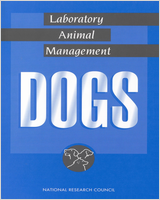It has been 2 decades since the Institute of Laboratory Animal Resources first published Dogs: Standards and Guidelines for the Breeding, Care, and Management of Laboratory Animals (National Academy of Sciences, Washington, D.C., 1973). During that period, great strides have been made in improving care and management techniques, making available specific-pathogen-free and purpose-bred dogs, and identifying dogs with precisely defined genetic disorders. The dog has proved to be "man's best friend," not only because it is considered a companion and family member, but also because its use in research has been associated with many breakthrough discoveries in human medicine (e.g., the discovery of insulin as a treatment for type I diabetes mellitus).
The same period has been characterized by increased public awareness and scrutiny of research funding, occupational health and safety, and animal welfare. New federal and state laws specifically intended to protect research animals have been promulgated and regulations established. In addition to presenting information relevant to the care and use of dogs in research and making recommendations based on an objective evaluation of that information, it was the committee's intent to incorporate in this report those aspects of canine husbandry embodied in federal law. Federal regulations and policies protecting dogs in research are therefore summarized in Chapter 1, which provides information for obtaining copies. Specific details of the regulations and policies are given throughout the text.
The committee firmly believes that good research requires a good animal-care program. The committee is also aware of the tremendous variation in physiologic traits among canine models. Dogs vary greatly in size, age, health status, physical conformation of the breed, behavioral characteristics, and experience. Therefore, no standard of animal care is likely to be optimal for all dogs. The committee recommends that performance standards be used with sound professional judgment in implementing the animal-care program.
Readers who detect errors of omission or commission or who have evidence to support improved procedures are invited to send suggestions to ILAR, National Research Council, 2101 Constitution Avenue, Washington, DC 20418.
The committee wishes to thank the entire staff of ILAR, but especially Dr. Dorothy Greenhouse and Ms. Amanda Hull, for assisting in the production of this manuscript. The committee also acknowledges the many fine contributions made to this report by scientists specializing in the care and use of dogs in research; their names appear on pages iv and v.
Fred W. Quimby, Chairman
Committee on Dogs
- Preface - Laboratory Animal ManagementPreface - Laboratory Animal Management
Your browsing activity is empty.
Activity recording is turned off.
See more...
